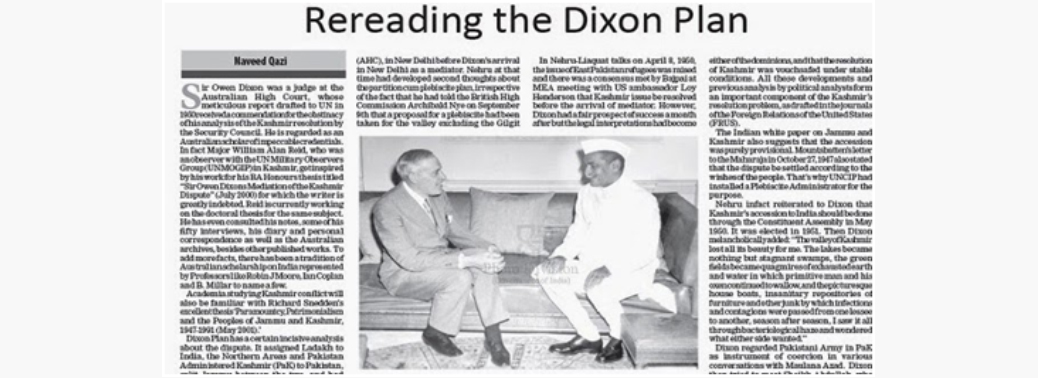DIXON PLAN OF 1950
07, Aug 2019

Prelims level : History- Modern History, Polity & Governance, Parliament
Mains level : GS-I- Post-independence consolidation and reorganization within the country.
Context-
- The idea of dividing Jammu and Kashmir into two or more parts has a chequered history, tracing its origin to the Dixon Plan of 1950.
Who Was Dixon?
- Owen Dixon was an Australian jurist chosen by the United Nations to mediate between India and Pakistan on the J&K issue.
- His report of September 1950, suggested a package that did not find acceptance from India.
Dixon Plan:
- Plan had assigned Ladakh to India and northern areas and Pakistan Occupied Kashmir to Pakistan, besides splitting Jammu between the two. It had proposed a plebiscite in the Kashmir valley.
- He saw the river Chenab as a natural border.
- This would have meant that most of the Muslim-dominated areas of what is Indian-administered Kashmir would go to Pakistan, but the Hindu-dominated area would have remained with India.
- The plan met with opposition from those with pro-independence sentiments, but it had a more serious flaw. The large wave of migration caused by the imposition of such a border would involve the displacement of many thousands of people, which could itself lead to violence.
- Limited Plebiscite
- A plebiscite be taken “by sections or areas” and the allocation of each section or area be made according to the result of the vote.
- Without holding a plebiscite, areas certain to vote for India and those certain to vote for Pakistan “be allotted accordingly and the plebiscite be confined only to the uncertain area”. The “uncertain area” according to Sir. Dixon appeared to be the “Vale of Kashmir and perhaps some adjacent country.”
- Ambedkar:
- B.R. Ambedkar, after quitting as Law Minister from the Jawaharlal Nehru Ministry, had suggested the formation of three zones: the area held by Pakistan, the Valley and Jammu Ladakh.
- He had also favoured a plebiscite only in the Valley.
Another Plan: Dickie Bird Plan, 1947:
- Mountbatten prepared “Dickie Bird Plan” for India’s independence.
- The main proposal of this plan was to that provinces should become first independent successor states rather than an Indian Union or the two dominions of India & Pakistan.
- As per this plan all the provinces viz. Madras, Bombay, United Provinces of Bengal, Punjab & North West Frontier etc. were proposed to be declared Independent.
- The states later would decide whether to join constituent assembly or not.
- This plan was not discussed in details with leaders of India and Mountbatten discussed just informally.
- He gave the plan a final touch and sent to London. Later when he moved to Shimla, Nehru joined him as a guest.
- Here the details of the plan were put by Mountbatten before Nehru. Nehru rejected the plan right away and told him that this plan would invite Balkanization of India and would provoke conflict and violence.
- Consequently, Mountbatten cabled to England that this plan was cancelled.






